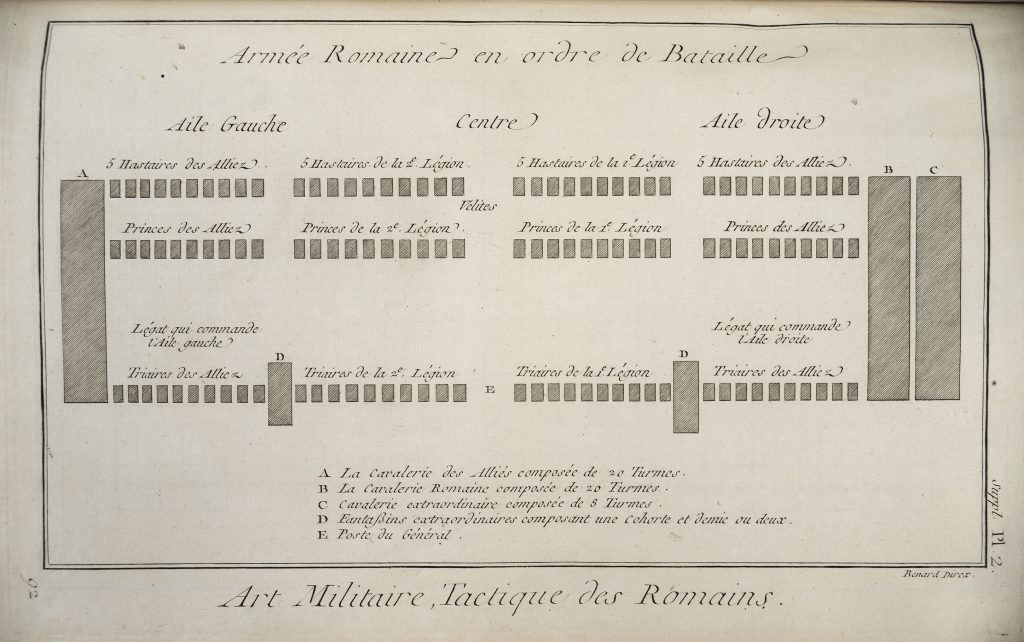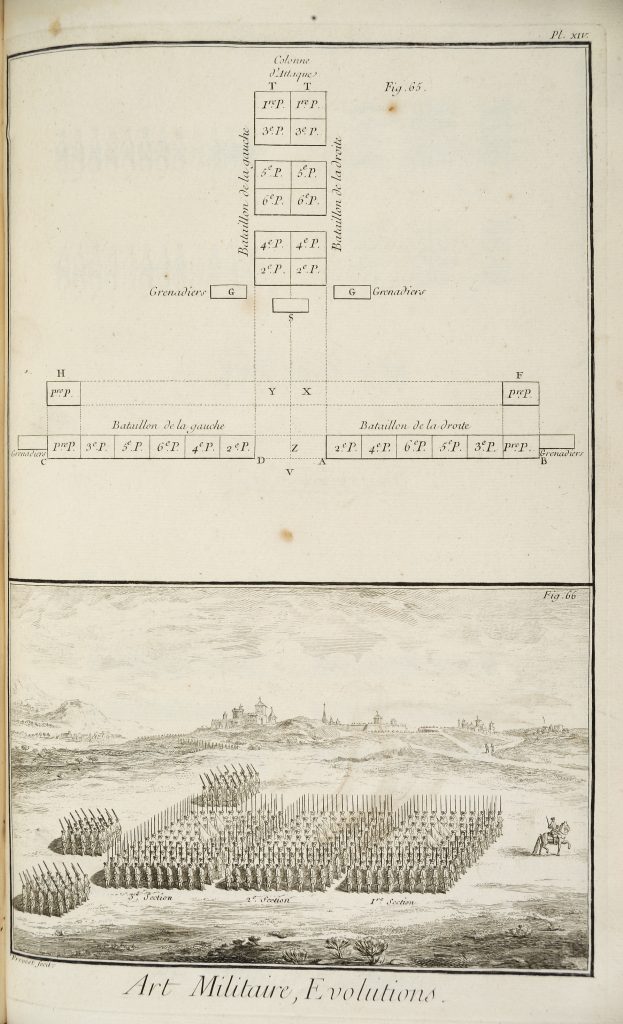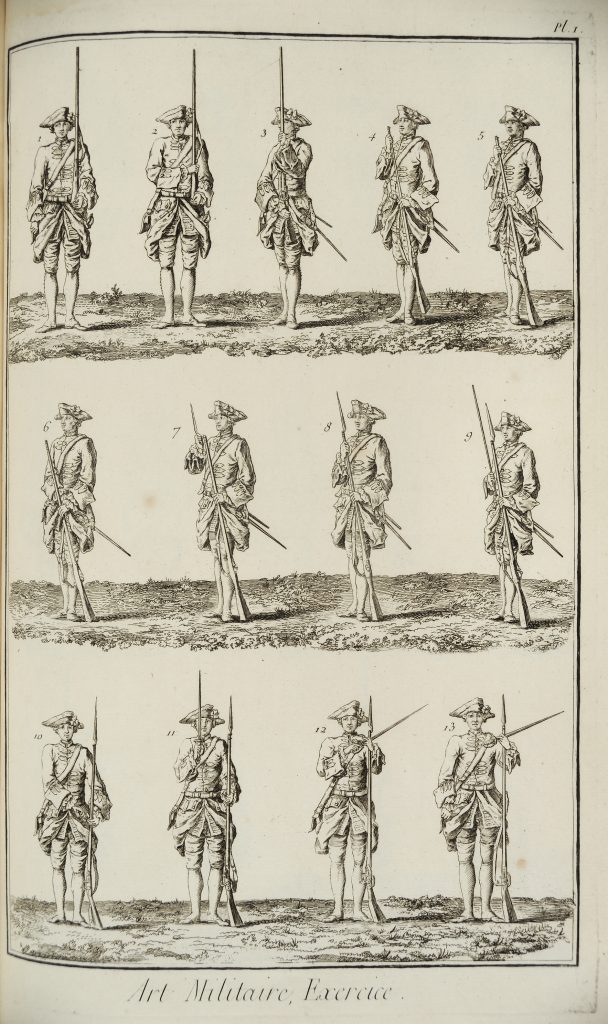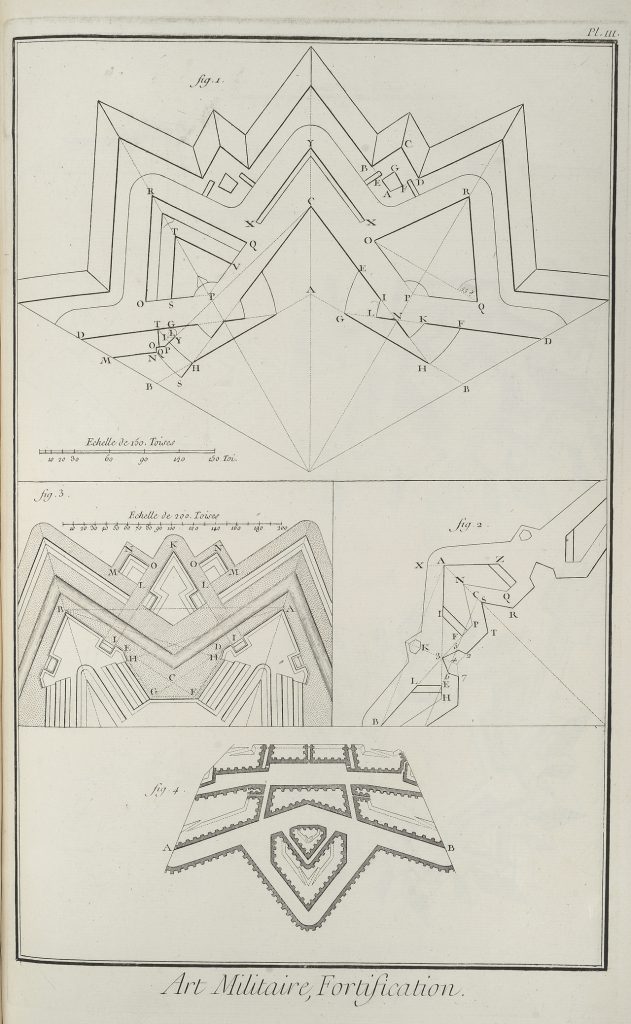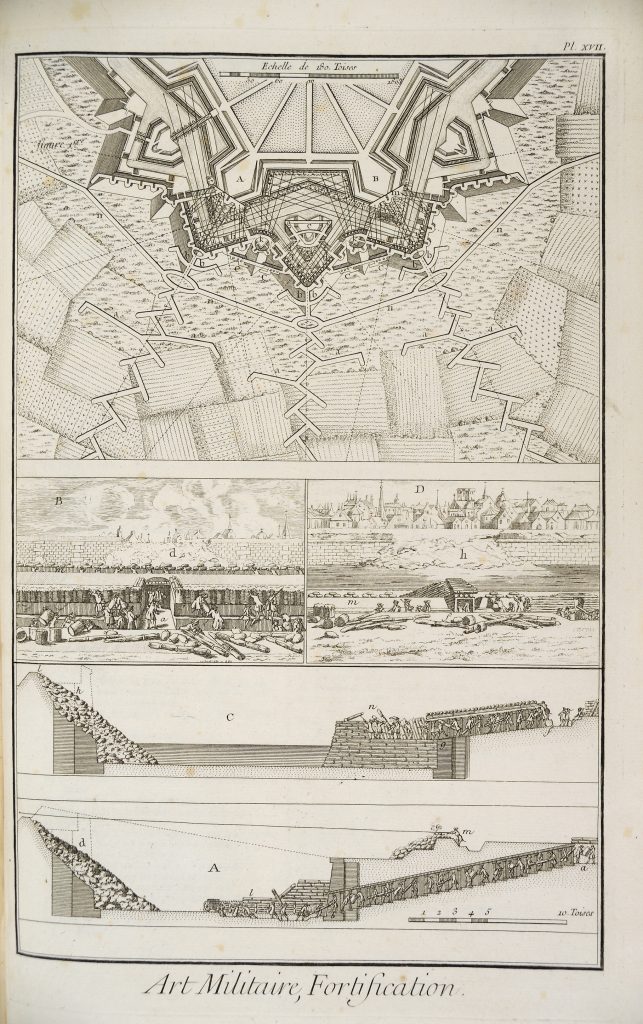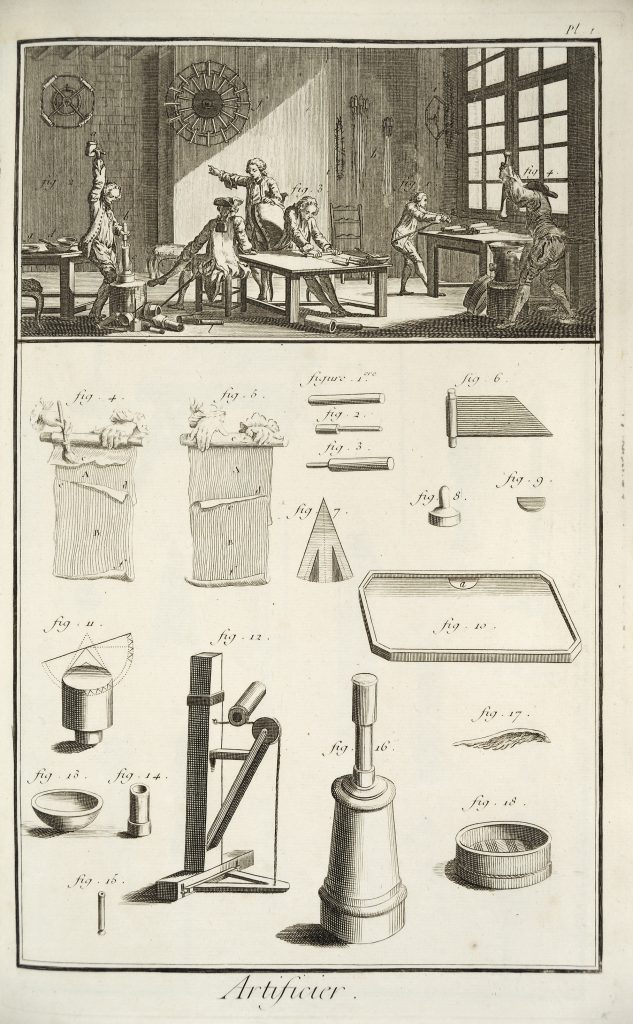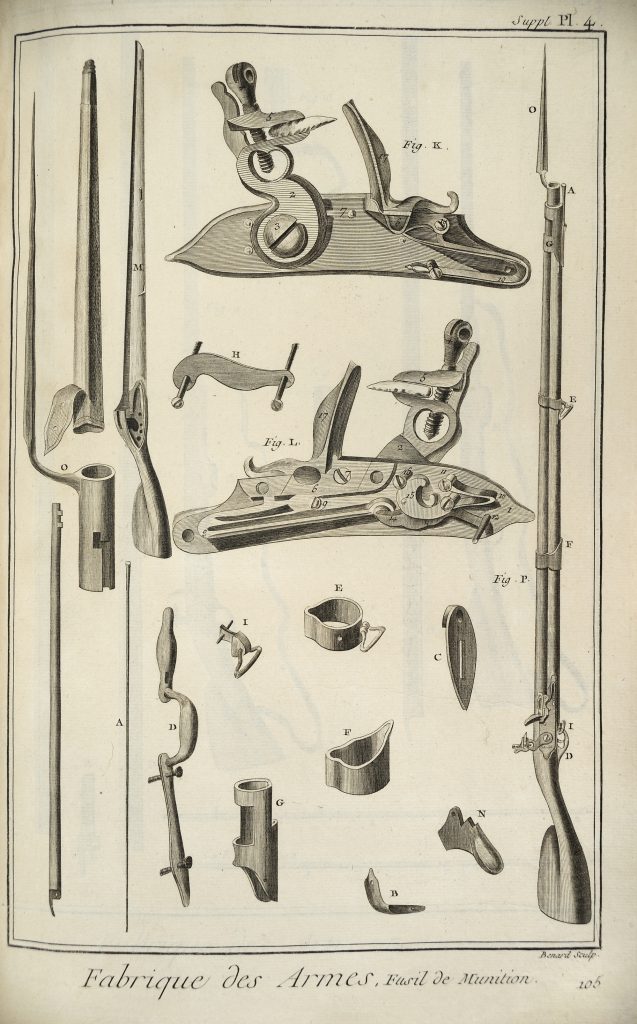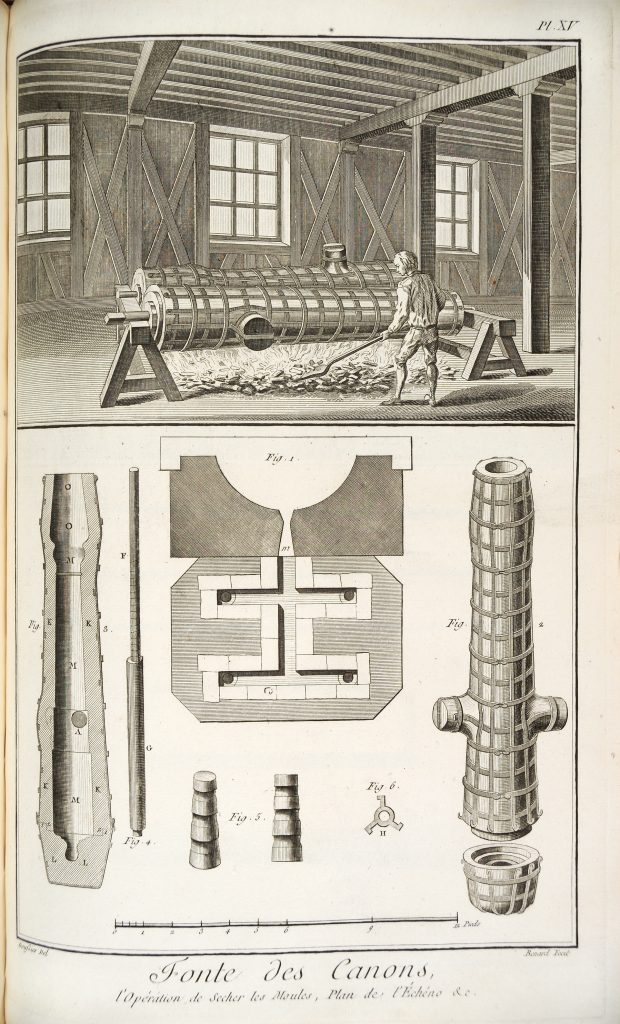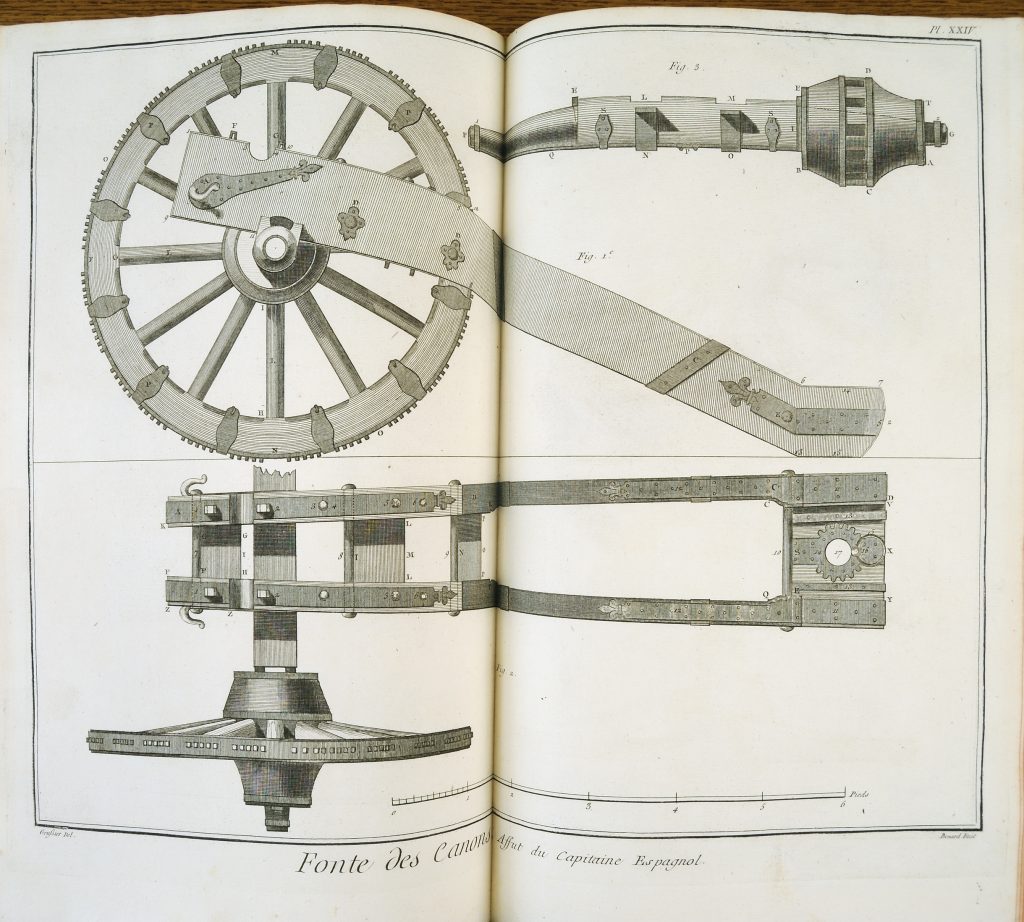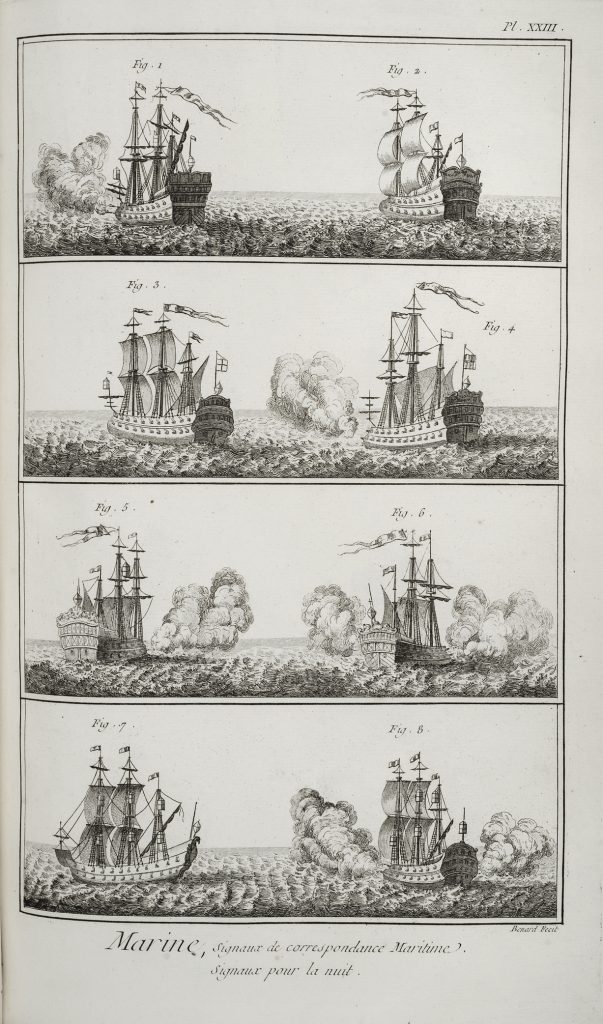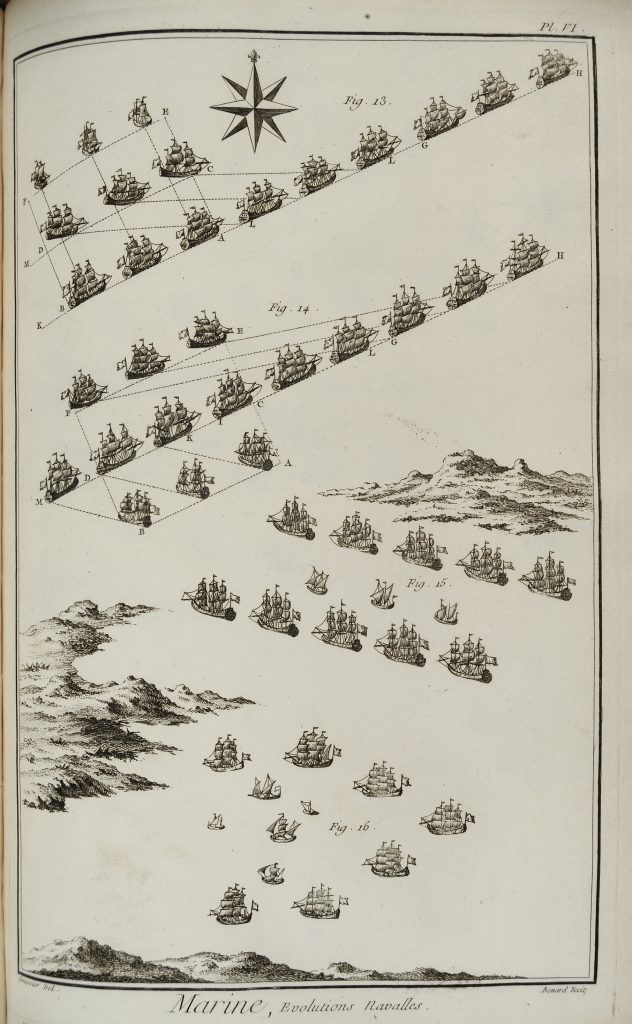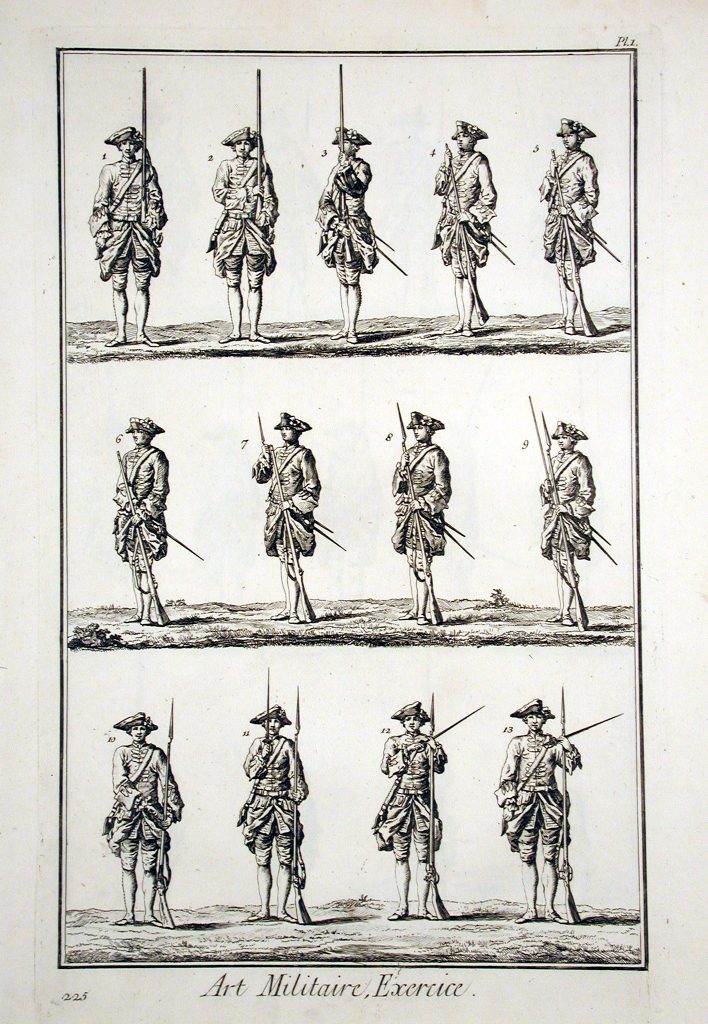
The first volume of plates of the Encyclopedie, a project edited primarily by Denis Diderot, includes a series of thirty-nine illustrations on the subject of military art. The first plate in the section, Art Militaire, Excercice, shows a standard thirteen-step exercise that moves from presenting arms to fixing one’s bayonet to drawing one’s sword.
The monumental Encyclopédie, ou Dictionnaire Raisonné des Sciences, des Arts, et des Métiers, edited by Denis Diderot and Jean Le Rond d’Alembert, was the first methodical endeavor to determine and present the entire scope of human knowledge. Published in Paris between 1751 and 1780, the thirty-five-volume work epitomizes the Age of Enlightenment as its contributors—known as the encyclopédistes—aimed to understand the world through reason, intellectual exchange and the scientific method. As part of the Robert Charles Lawrence Fergusson Collection, which specializes in works relating to the art of war, the Institute’s complete first edition of the Encyclopédie provides insight into the intellectual discourse on the theory and practice of warfare in the era of the American Revolution.
The editors, Diderot and d’Alembert, defined the goals of the Encyclopédie in the preface of their first volume: “As an Encyclopedia, it is to define as well as possible the order and structure of human knowledge. As a Reasoned Dictionary of the Sciences, Arts, and Trades, it is to contain the general principles that form the basis of each science and each art, liberal or mechanical, and the most essential facts that make up the body and substance of each.” Their ambitions, combined with their personal political and religious views, sparked controversies that nearly doomed the project. D’Alembert resigned as editor in 1757, and soon thereafter the French parliament and Louis XV condemned the Encyclopédie as subversive and revoked its privilege, or publishing license. Publication continued clandestinely. Diderot remained chief editor for the duration of the project, and by 1780 the Encyclopédie was complete, comprising seventeen volumes of text containing seventy-four thousand entries, eleven volumes of plates, five supplementary volumes and a two-volume index. The significance of the Encyclopédie’s unprecedented effort to democratize human knowledge was recognized in its day. The emphasis on arts et métiers (arts and trades) focused attention on the everyday accomplishments of working people rather than the aristocracy.
The Age of the Enlightenment was also an era of nearly constant war in Europe and North America. The Encyclopédie reflects the growing significance of the art of war in an evolving eighteenth-century military. Military officers relied on and frequently referred to works such as the Encyclopedie to provide practical education on the theory and practice of war. The text volumes provide nearly 1,250 articles on military subjects relating to the history of warfare, the manufacture of arms, fortification and siege warfare, artillery, and tactics, strategy and handling armies in the field. Some of these subjects include the history of the Roman military organizations, contemporary ballistics, the construction of artillery pieces, the use of siege guns and mortars, column formations, uniforms, recruitment of soldiers, ranks, passageways in fortifications, water level bridges, the oath of soldiers, and tactical advantages and disadvantages of terrain. While much of the military content is focused on technical matters of land warfare, the Encyclopédie also includes articles on naval subjects, such as shipbuilding and naval evolutions. Nearly all of these subject entries have corresponding printed plates that are bound separately in one of the eleven volumes of exquisitely detailed engravings for which the Encyclopédie is best known.
In addition to the articles classified as military subjects are entries that address the political or moral questions of war. The encyclopédistes were ambivalent about war. The article titled “Victoire,” for example, states, “Winning a battle, or the victory, is always uncertain and the loss of men is always very great; prudence and humanity only permit action of this kind in the case of absolute necessity and when it is impossible to do otherwise without being exposed to troublesome consequences. If one can avoid it, it is not excusable to risk the lives of so many brave soldiers whose loss is irreparable.”
The military history in the Encyclopédie focuses on the evolution of military art and science rather than expanding on specific historical military campaigns. This choice is consistent with the encyclopédistes’ preference for highlighting the factual and objective in everyday life over the achievements of the upper echelon of society. The detailed articles and plates demonstrate that what had been generally regarded and derided as “humbler trades” were in fact vocations that required sophisticated skills; the tools and techniques of war were sophisticated and worthy of study. The encyclopédistes recognized the duality of just and unjust wars with relation to republics and monarchies. The overall political, economic and religious philosophy of the Encyclopédie underlined the individual’s responsibility in the world and placed greater emphasis on man’s significance in and of himself.
Nearly three-quarters of the entries on the art of war were written by Guillaume Le Blond, a mathematics professor and tutor to the children of Louis XV, with twenty-eight entries alone focusing on fortification. Though he lacked practical military experience, Le Blond focused on the technical aspects of military theory. He presented the views of well-known contemporary and historical military theorists, citing Puységur, Vauban, Folard, Caesar and Vegetius, among others. In his entry on “Guerre” he outlined the theory of war as rules and principles that rely both on classical authors from antiquity and on developments by contemporary military authors, most of whom were French.
Louis, chevalier de Jaucourt, an aristocrat and gentleman scholar, wrote nine percent of the entries on the art of war, the second most after Le Blond. Jaucourt also contributed to roughly a quarter of the total entries in the entirety of the Encyclopédie. He mainly focused on historical and political subjects, with a special interest in the classical era. He wrote almost a third of the Encyclopédie’s 161 entries on weapons and techniques throughout history, the majority of which were on the contributions of Roman armies. Of the entries not classified as military, he wrote on topics such as “Despotisme,” “Démocratie,” “Patriote,” “Tyrannie” and “République d’Athènes.” Le Blond and Jaucourt’s synthesis of the important theoretical and practical questions of war are foundational to the military history contained in the Encyclopédie.
In addition to the sizable contributions of Le Blond and Jaucourt, a number of other authors contributed to the entries on the art of war, including Diderot himself. Most of his military entries pertain to the topics of technology and methodology, which became Diderot’s primary focus throughout the Encyclopédie. Other noted military contributors include Abbé Mallet, Charles-Louis d’Authville des Amourettes and Jacques François Blondel.
The writings of the Encyclopédie’s military philosophes influenced the generation of French, British and American officers who fought in the American Revolutionary War. Although the final volumes were not completed until 1780 (and it was not a work designed to be carried into the field), the ideas of military practice, theory and innovation the work presented were already widely circulating in military manuals and treatises by these authors and others. At least one set of the Encyclopédie did arrive in America during the war. In 1780, Thomas Jefferson, then governor of Virginia, made arrangements to purchase a set for “public use.” The war delayed its delivery until December 1781, and Jefferson kept and studied the set at Monticello for at least a year, much to the consternation of the Virginia legislature. (Jefferson’s arrangement of his personal library was inspired by Diderot’s classification system.) American statesman Gouverneur Morris owned a set of the Encyclopédie that was shipped to him in Philadelphia in its original pasteboard covers and custom bound for him by Robert Aitken, a leading printer and publisher during the Revolution. Revolutionary War veteran James Monroe owned a set as did the College of William and Mary.
Diderot’s Encyclopédie was a crowning achievement of the art of printing, a trade well documented in the work’s text and plates. The Institute’s set is a showcase example—large folio volumes bound in their original polished calf bindings with finely tooled letters and decorations in gold leaf. Though the provenance of the Institute’s Encyclopédie is not fully known, the volumes contain tantalizing clues to the history of their previous ownership. The only manuscript annotations in the set are found on an engraved plate detailing the human skeleton. On the engraving, the name and location of each bone of the skeleton are inscribed, taken from a key at the start of the volume—presumably for ease of study. There is also evidence of a previous owner’s interest in botany, given the multitude of vegetation samples found preserved within. Ferns, reeds and wildflowers are carefully pressed between the pages throughout the volumes. Lastly, a piece of blank stationary laid into volume fifteen gives an indication of one possible location for a previous owner of this Encyclopédie. The quality of the stationary and the typography suggests it dates from the late nineteenth century. The heading lists a “Ferme de Chevry, P. Giot, cultivateur, par Brie-Comte-Robert, Seine-et-Marne”—probably referring to Parfait Giot, a farmer and community leader in Brie-Comte-Robert, a small town southeast of Paris, whose obituary was published in the Briard Almanach Républicain of 1896. This cannot paint a full picture of its history; however, the ephemera discovered throughout the Encyclopédie’s volumes provide an intriguing glimpse into how such a resource could have been put to practical use through the generations since its publication.
Now a centerpiece of the Institute’s Fergusson Collection, this superb set of the Encyclopédie offers a window into the eighteenth century on the eve of social and industrial revolution. Not only does it serve as representative of the complex philosophical, social and scientific debates during the Enlightenment, on a practical level the Encyclopédie served as a trusted compendium for the theory and practice of warfare, as well as providing a window into everyday life and work.
View More Rare Books
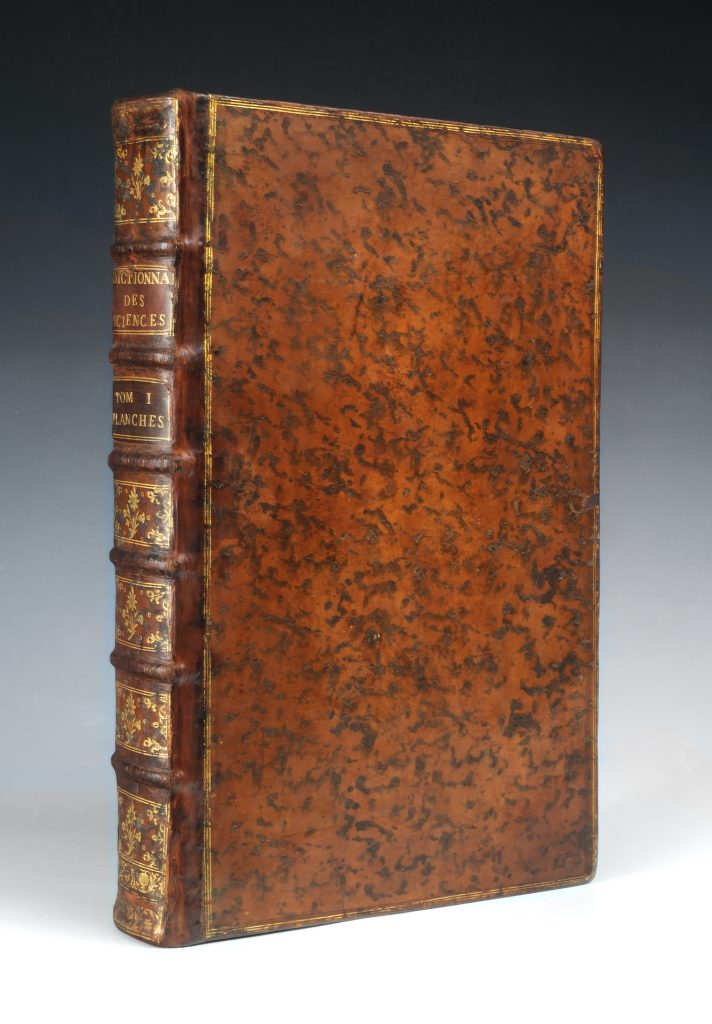
Encyclopédie, ou Dictionnaire Raisonné des Sciences, des Arts, et des Métiers
Denis Diderot and Jean Le Rond d’Alembert
Paris: Chez Briasson, 1751-1765The Robert Charles Lawrence Fergusson Collection
The Institute’s set of the first edition of the Encyclopédie is bound in its original finely tooled leather binding.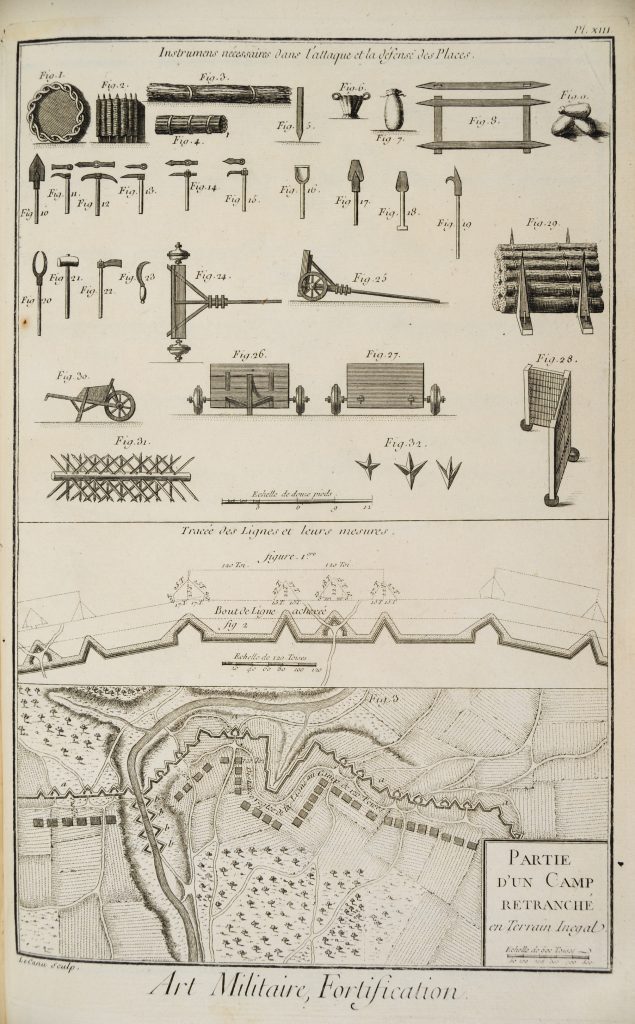
Art Militaire, Fortification
Tom I Planches, Plate XIII
A. Le Canu, engraver
The Robert Charles Lawrence Fergusson Collection
This plate illustrates in three sections the necessary tools for the defense of a fortification, how to draw the lines of a fortification and measure them, and a map of a camp dug into uneven ground.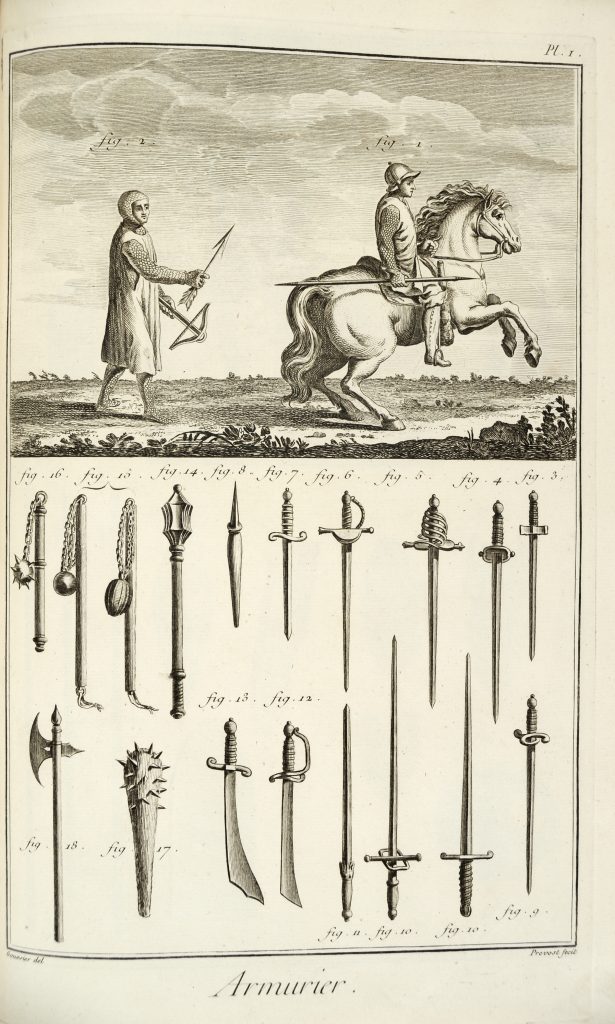
Armurier
Tom I Planches, Plate I
Benoît Louis Prévost, engraver; after Louis-Jacques Goussier, artist
The Robert Charles Lawrence Fergusson Collection
This plate demonstrates the encyclopedists’ interest in military history and depicts medieval soldiers at top, with images of medieval weapons below.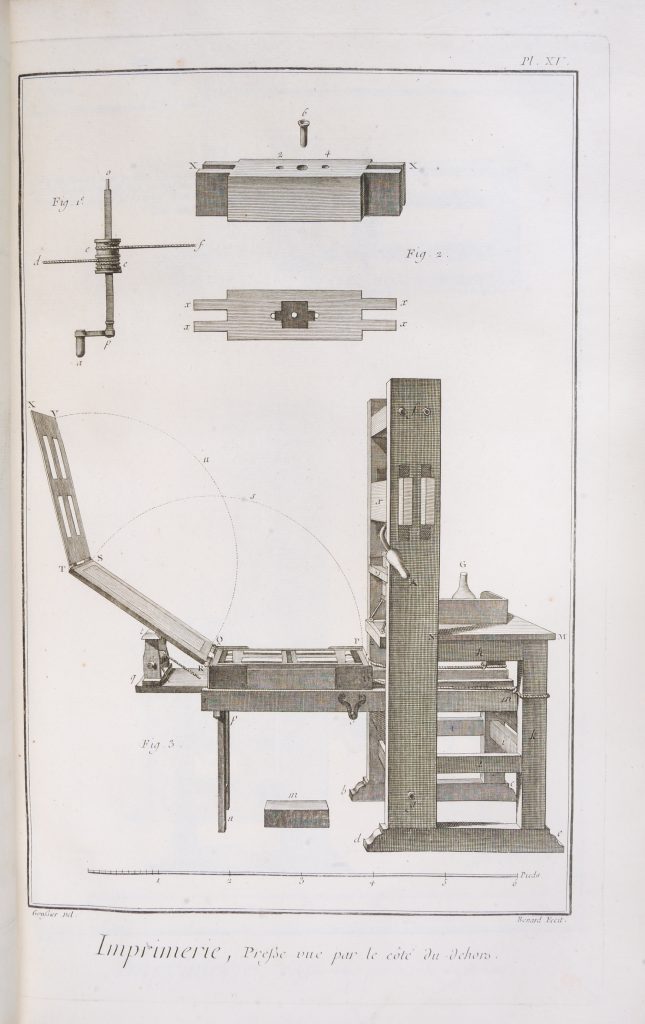
Imprimerie, Presse Vue par le Côté du Dehors
Tom VII Planches, Plate XV
Robert Bénard, engraver; after Louis-Jacques Goussier, artist
The Robert Charles Lawrence Fergusson Collection
This engraving depicts the printing mechanism from the side, and demonstrates how to fold the machine for pressing.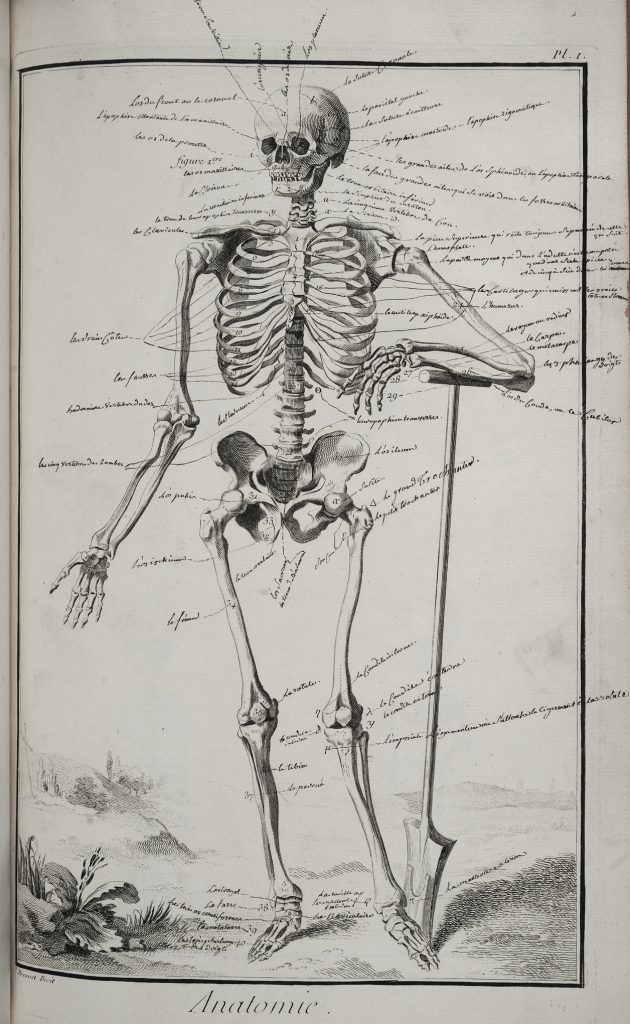
Anatomie
Tom I Planches, Plate I
Benoît Louis Prévost, engraver
The Robert Charles Lawrence Fergusson Collection
This plate of a skeleton is the only annotated image found in the Institute’s set of the Encyclopédie. The name and location of each bone is inscribed with information from a key at the start of the volume.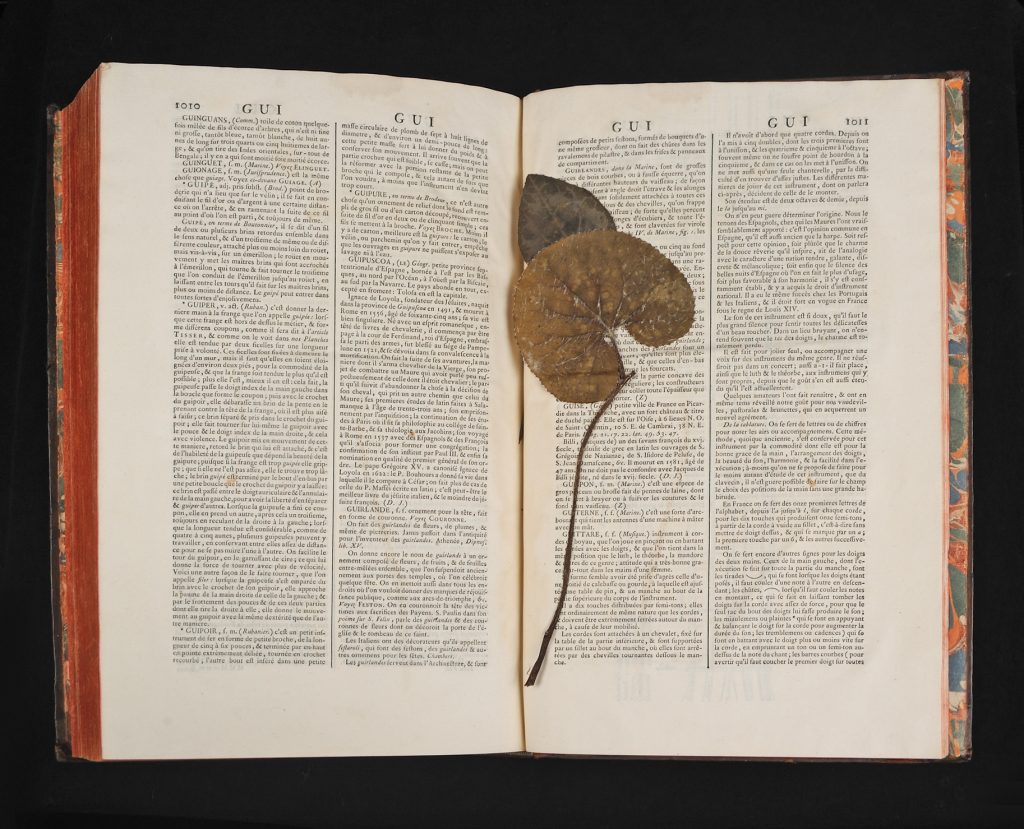
Encyclopédie, ou Dictionnaire Raisonné des Sciences, des Arts, et des Métiers
Denis Diderot and Jean Le Rond d’Alembert
Paris: Chez Briasson, 1751-1765The Robert Charles Lawrence Fergusson Collection
Evidence of a previous owner’s interest in botany is suggested by pressed plant material found in volume seven of the Institute’s set.